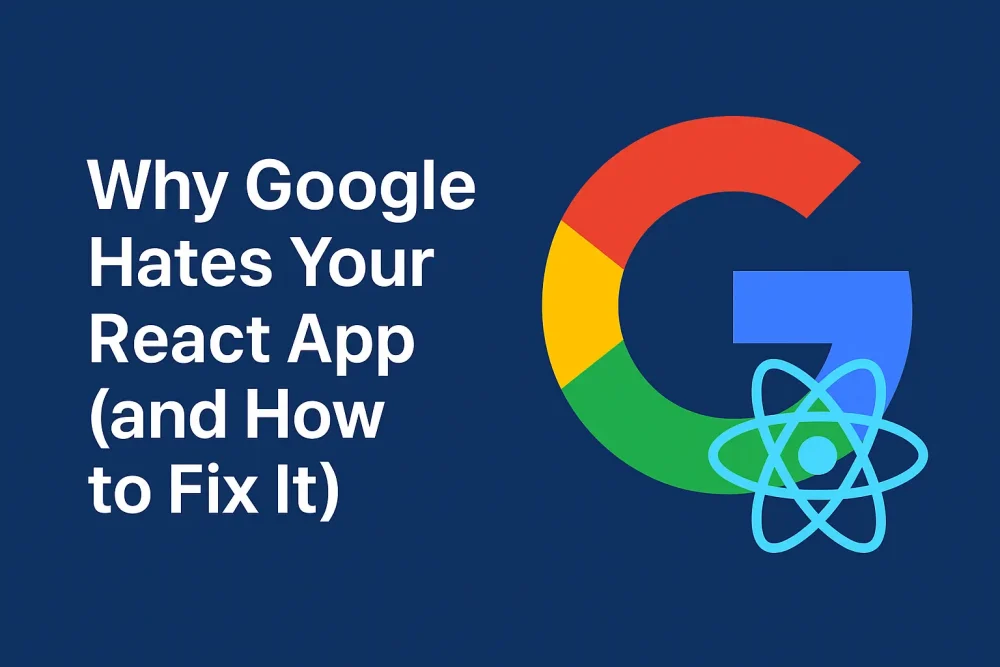Introduction
You built your React app. It looks sharp, loads fine on your laptop, and your users love it. But when you search on Google, your app is nowhere to be found.
This is a common pain point for ReactJS developers and product owners. I’ve seen it many times. A team spends months perfecting their app, only to discover that Google can’t read it. The problem isn’t React itself—it’s how we ship React apps to the web.
In this guide, I’ll explain why Google struggles with React, how you can check if your app has SEO issues, and practical fixes you can apply today.
Why Google “Hates” React Apps
Client-Side Rendering
Most React apps use client-side rendering (CSR). That means your app ships a mostly empty HTML file. The real content shows up later when JavaScript runs.
Humans don’t notice this delay, but Googlebot isn’t as patient. Sometimes it crawls the page before the content loads. To Google, your page looks blank.
Empty Source Code
Try this: right-click on your React app and hit “View Page Source.” What do you see? Probably just a <div id=”root”></div>.
That’s fine for browsers. But search engines prefer HTML with actual text and links. If the source is empty, indexing suffers.
Slow Load Times
React apps can get heavy. Large JavaScript bundles, unoptimized images, and unnecessary re-renders slow things down. Google cares about Core Web Vitals. If your site loads in 5 seconds, rankings will drop.
Routing and Metadata Issues
React Router is great for building single-page apps. But unless you set it up right, Google might miss your dynamic routes.
Metadata is another problem. Without tools like React Helmet, every page shares the same title and description. That’s an SEO killer.
The Misconception: “Google Can Render JS Now”
Yes, Googlebot can render JavaScript. But here’s the catch: it does this in two steps. First it crawls, then later it renders scripts. If resources fail or timeouts happen, your content may never appear in the index.
I’ve seen apps where Google indexed only the login page because everything else needed JS to load. That’s why relying on “Google can handle JS” is risky.
Signs Your React App Has SEO Issues
How do you know if your React app is invisible to Google? Here are common red flags:
- Pages are missing from Google Search Console’s index report.
- Titles and meta descriptions don’t match what you expect.
- When you search “site:yourdomain.com” on Google, only a handful of pages show.
- Competitors with weaker apps rank above you.
If these sound familiar, don’t worry—you can fix it.
How to Fix SEO Issues in React Apps
1. Use Server-Side Rendering (SSR)
Server-side rendering sends Google a fully built HTML page instead of a blank shell.
Frameworks like Next.js and Remix make this easy. Instead of waiting for JavaScript, Google sees the actual content right away.
If I were starting a React project today, I’d use Next.js by default. It saves headaches with SEO, routing, and performance.
2. Try Static Site Generation (SSG)
Static site generation builds HTML at compile time. This works well for pages that don’t change often, like blogs, product listings, or docs.
Next.js and Gatsby are great here. They pre-render pages into static HTML and then hydrate with React. That means fast loads and Google-friendly HTML.
3. Use Dynamic Rendering as a Short-Term Fix
If migrating your whole app isn’t possible yet, try dynamic rendering. Tools like Rendertron or Prerender.io serve bots a pre-rendered HTML snapshot while keeping CSR for users.
It’s not perfect, but it’s a quick win if you need Google visibility fast.
4. Add Metadata Correctly
Every page needs unique titles, meta descriptions, and social tags. Use:
- React Helmet in traditional React apps.
- next/head in Next.js.
Example:
import { Helmet } from “react-helmet”;
<Helmet>
<title>Buy Shoes Online | MyStore</title>
<meta name=”description” content=”Shop the latest sneakers at MyStore. Free shipping on all orders.” />
</Helmet>
This makes sure each page has the right metadata for search engines.
5. Improve Core Web Vitals
Google measures three things:
- Largest Contentful Paint (LCP): Should be under 2.5s.
- First Input Delay (FID): Should be under 100ms.
- Cumulative Layout Shift (CLS): Should be under 0.1.
How to fix:
- Split your JS bundles (React.lazy, Suspense).
- Compress and lazy-load images.
- Minify CSS/JS.
- Use a CDN.
I once worked on a store where fixing image compression alone cut load time in half. Rankings improved within weeks.
6. Set Up a Sitemap and Robots.txt
- Generate an XML sitemap and submit it to Google Search Console.
- Double-check robots.txt isn’t blocking your JS or API endpoints.
This helps Google crawl your app faster and more accurately.
Quick Wins for Busy Owners
I know many of you run lean teams. You don’t always have time to migrate to Next.js tomorrow. Here are smaller fixes you can apply right now:
- Add a prerendering service for key pages.
- Compress images and use WebP.
- Install React Helmet for metadata.
- Reduce unused npm packages to shrink bundle size.
These won’t solve every issue, but they can boost visibility while you plan bigger changes.
Tools You Should Use
Here are tools I recommend to React app owners:
- Google Search Console: Check indexing and errors.
- Lighthouse (in Chrome DevTools): Test speed and SEO scores.
- Screaming Frog SEO Spider: See what Google actually renders.
- Ahrefs or SEMrush: Track keywords and monitor growth.
Checking these monthly can prevent nasty surprises.
Personal Story
A few years ago, I helped a startup with a ReactJS Development services that looked amazing but got zero traffic from Google. They were frustrated because they had written hundreds of product pages, but none ranked.
We switched them to Next.js, cleaned up their metadata, and fixed load speed. Within 90 days, traffic grew by 400%. They didn’t change their content—just the way Google saw it.
That experience taught me something simple: if you want your React app to grow, don’t ignore SEO.
Conclusion
Google doesn’t hate React. It just hates poorly configured React apps. The good news? You don’t need to rebuild from scratch.
Start small. Add metadata. Fix performance. Try prerendering. If you have the resources, migrate to SSR with Next.js.
Your app can look great and rank on Google. You just have to serve both humans and bots.



